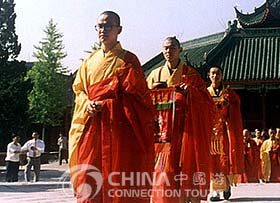
 Located in downtown of Kaifeng city, Xiangguo temple is one of the most famous Buddhist temples in China. It was originally built in 555 AD during the Northern Qi Dynasty; it has a history of over 1,400 years. In the Northern Song Dynasty, the temple was enlarged many times and became the largest temple and the national Buddhist center at that time. It was firstly named Jianguo Monastery, in 712 AD, it was given the name the Great Xiangguo Temple by the Emperor Reizong in memory of his ascending to the throne of emperor from the former position of King Xiang. During the Northern Song Dynasty, it was deeply worshipped and respected by the royal family enlarging for several times, it once occupied an area as large as 500 mu of land, with 64 meditation yards, law yards under its administration, with more than 1,000 monks, being the biggest monastery in the capital city and the center of national Buddhist activities. Later it was destroyed by a Yellow River flood at the end of the Ming Dynasty (1368-1644), and it was reconstructed again at the beginning of the Qing Dynasty. The temple's main attraction is the magnificent four-sided statue of Avalokitesvara (the male Indian bodhisattva who became transfigured over the years into the female Guanyin), with a thousand hands and a thousand eyes (all-seeing and
Located in downtown of Kaifeng city, Xiangguo temple is one of the most famous Buddhist temples in China. It was originally built in 555 AD during the Northern Qi Dynasty; it has a history of over 1,400 years. In the Northern Song Dynasty, the temple was enlarged many times and became the largest temple and the national Buddhist center at that time. It was firstly named Jianguo Monastery, in 712 AD, it was given the name the Great Xiangguo Temple by the Emperor Reizong in memory of his ascending to the throne of emperor from the former position of King Xiang. During the Northern Song Dynasty, it was deeply worshipped and respected by the royal family enlarging for several times, it once occupied an area as large as 500 mu of land, with 64 meditation yards, law yards under its administration, with more than 1,000 monks, being the biggest monastery in the capital city and the center of national Buddhist activities. Later it was destroyed by a Yellow River flood at the end of the Ming Dynasty (1368-1644), and it was reconstructed again at the beginning of the Qing Dynasty. The temple's main attraction is the magnificent four-sided statue of Avalokitesvara (the male Indian bodhisattva who became transfigured over the years into the female Guanyin), with a thousand hands and a thousand eyes (all-seeing and  compassionate), who stands surrounded by 500 arhats. Weighing 2,000 kilograms (2.2 tons), the 7m (23-ft.) high statue was said to have been carved from the trunk of a thousand-year-old ginkgo tree and required 58 years to complete.
compassionate), who stands surrounded by 500 arhats. Weighing 2,000 kilograms (2.2 tons), the 7m (23-ft.) high statue was said to have been carved from the trunk of a thousand-year-old ginkgo tree and required 58 years to complete.
At present, the existing structures of the temple are the Grand Hall, the Octagonal Hall, the east and west chambers, and other buildings holding Buddhist sutras. Inside the Octagonal Hall there is a wooden statue of the Goddess of Mercy with many hands and eyes which was carved during the reign of Emperor Qian Long (1736 -1795) of the Qing Dynasty and which is regarded as a masterpiece of wood carving from that era.
Today it has become the center for major Buddhist activities in Henan Province.

